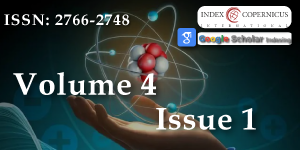Influence of high frequency rotating magnetic field on the effect of heating magnetic fluid
Main Article Content
Abstract
The article describes the necessary conditions for the phenomenon of thermal energy release in a magnetic fluid placed in a high-frequency rotating magnetic field. The minimum amplitude of the magnetic field was calculated and the thermal power released (by the rotating spherical nanoparticles in the viscous medium) was estimated. The estimations were based on the assumption that the magnetic relaxation times (τN and τB) and the magnetic field rotation period (τrot) meet the condition: τN>>τrot>>τB. The principle of operation and construction of the device generating a high-frequency rotating magnetic field is described. Preliminary experimental studies were carried out using a magnetic fluid with magnetite nanoparticles that indicated magnetic relaxation as the cause of the released heat. The value of the absorption rate in the experiment and its dependence on the strength of the magnetic field were determined.
Article Details
Copyright (c) 2021 Skumiel A.

This work is licensed under a Creative Commons Attribution 4.0 International License.
Turkyilmazoglu M. Magnetohydrodynamic moving liquid plug within a micro-channel: Analytical solutions. J Biomech Eng. 2021; 143: 011012.
Turkyilmazoglu M. Single phase nanofluids in fluid mechanics and their Hydrodynamic linear stability analysis. Comput Methods Programs Biomed. 2020; 187: 105171. PubMed: https://pubmed.ncbi.nlm.nih.gov/31785535/
Turkyilmazoglu M. Nanoliquid film flow due to a moving substrate and heat transfer. Eur Phy J Plus. 2020; 135: 781.
Turkyilmazoglu M. Effects of uniform radial electric field on the MHD heat and fluid flow due to a rotating disk. Int J Eng Sci. 2011; 51: 233-240.
Rosensweig RE. Heating magnetic fluid with alternating magnetic field. J Magn Magn Mater. 2002; 252: 370-374.
Dutz S, Hergt R. Magnetic particle hyperthermia – a promising tumor therapy? 2014; 25: 452001. PubMed: https://pubmed.ncbi.nlm.nih.gov/25337919/
Skumiel A, Leszczyński B, Molcan M, Timko M. The comparison of magnetic circuits used in magnetic hyperthermia. J Magn Magn Mater. 2016; 420: 177-184.
Beković M, Trlep M, Jesenik M, Hamler A. A comparison of the heating effect of Magnetic fluid between the alternating and rotating magnetic field. J Magn MagnMater. 2014; 355: 12-17.
Sharapova VA, Uimin MA, Mysik AA, Ermakov AE. The Physics of Metals and Metallography, Heat Release in Magnetic Nanoparticles in AC Magnetic Fields. 2010; 110: 5-12.
Egolf PW, Shamsudhin N, Pane S, Vuarnoz D, Pokki J, et al. Hyperthermia with rotating magnetic nanowires inducing heat into tumor by fluid friction. J Appl Phy. 2016; 120: 064304.
Eisberg RM, Lerner LS. Physics, Foundations and Applications, McGraw-Hill Book Company, New York, Magnetic Dipoles and Their Applications, 1981; 24: 1140-1149.
Landau LD, Lifszyc EM. Viscous Liquid, Flow for small Reynolds numbers, Hydrodynamics, Wydawnictwo Naukowe PWN, Warszawa, Chapter II. 1994: 81-92.
Skumiel A, Hornowski T, Józefczak A, Koralewski M, Leszczyński B. Uses and limitation of different thermometers for measuring heating efficiency of magnetic fluids. Appl Ther Engi. 2016; 100: 1308-1318.
Skumiel A, Kaczmarek-Klinowska M, Timko M, Molcan M, Rajnak M. Evaluation of powerheatlosses in multidamain iron particlesunder the influence of AC magnetic field in RF Range. Int J Thermophysics. 2013.
Skumiel A, Kertmen A, Nowaczyk G. Investigation of the magnetic Hyperthermia effect in anaqueous dispersion of colloidosomal nanoparticle clusters. J Mol Liquids. 2019; 283: 91–95.

